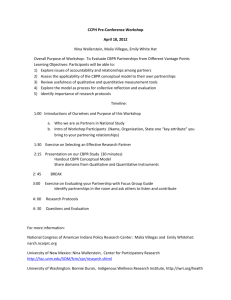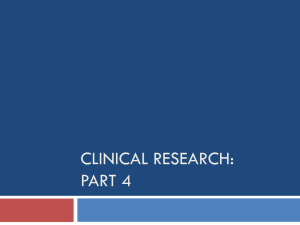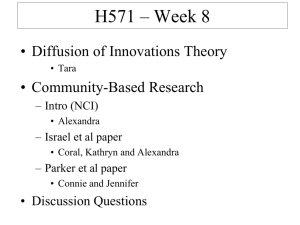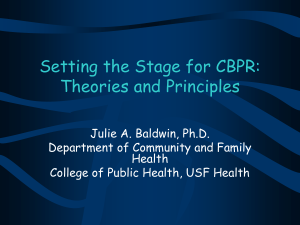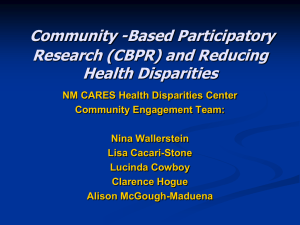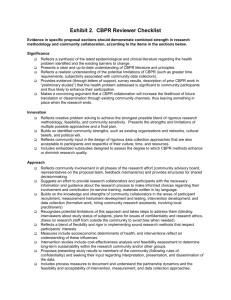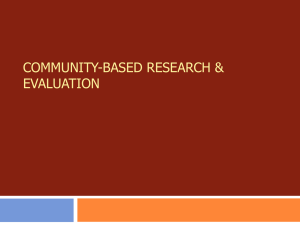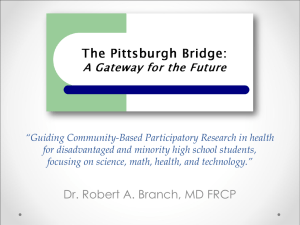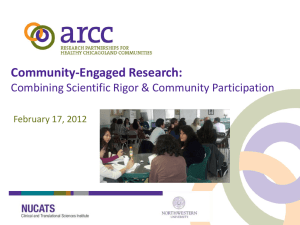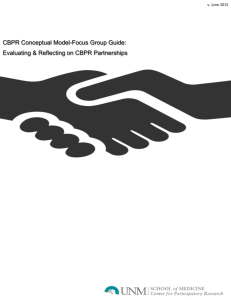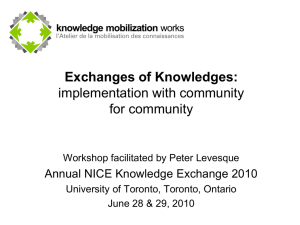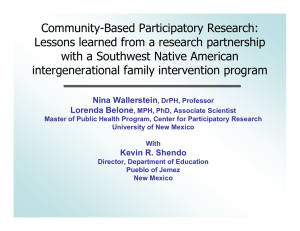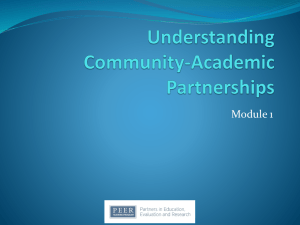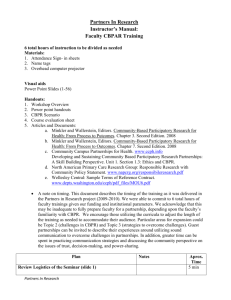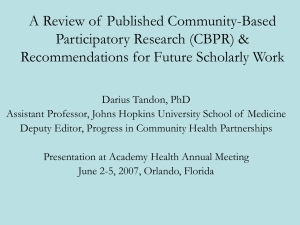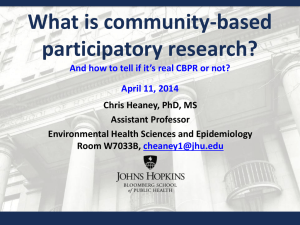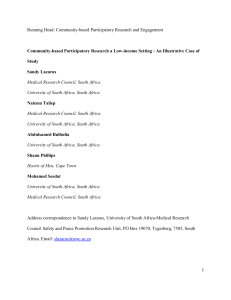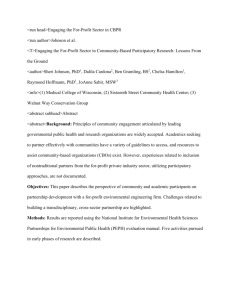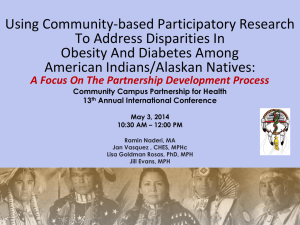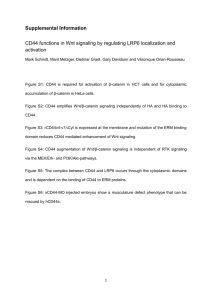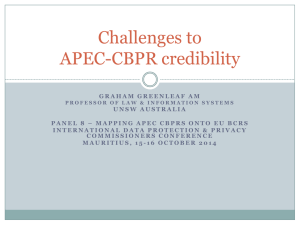Research for Improved Health - Community Campus Partnerships
advertisement
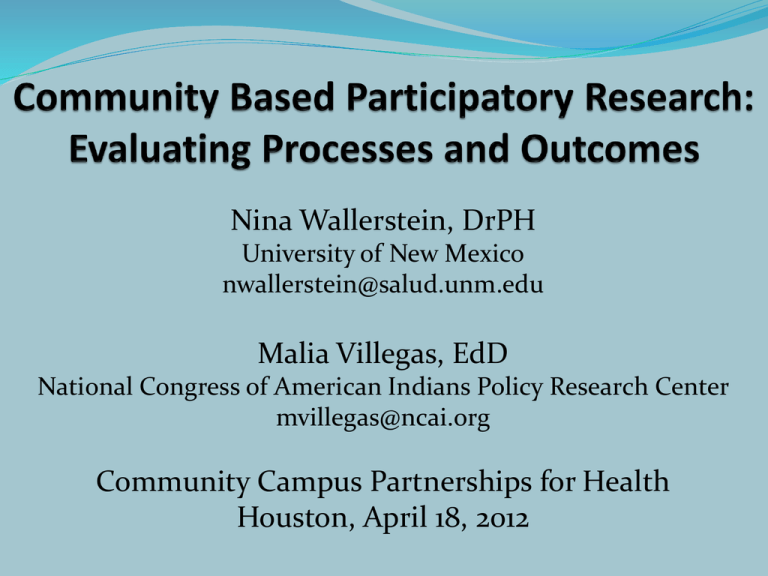
Nina Wallerstein, DrPH University of New Mexico nwallerstein@salud.unm.edu Malia Villegas, EdD National Congress of American Indians Policy Research Center mvillegas@ncai.org Community Campus Partnerships for Health Houston, April 18, 2012 Research for Improved Health: A National Study of CommunityAcademic Partnerships Overall Goal: To examine the facilitators and barriers to effective community- academic partnerships to improve health and health equity in AI/AN communities and other communities which face disparities Partners: (2009-2013) National Congress of American Indians Policy Research Center University of New Mexico Center for Participatory Research University of Washington Indigenous Wellness Research Institute Funding: Native American Research Centers for Health (NARCH V): NIH/Indian Health Service partnership History Three-Year Pilot: National Center of Minority Health and Health Disparities (2006-2009) (Wallerstein/Duran: PI) National Advisory Board (CBPR Think Tank) Literature Review (2003-2008): PubMed, Business Premier, Psych Info, SciSearch, Communication and Mass Media; Key Words: Community Based Participatory Research, CBPR, participatory research, action research, participatory action research, participatory evaluation, community driven research, action science, collaborative inquiry, empowerment evaluation From over 2000 articles, 287 reviewed, used to generate model characteristics Internet Survey (Appropriateness of Characteristics) Development of Model (Wallerstein et al, 2008; Chapter in CBPR and Health: Process to Outcomes, 2nd edition) Research for Improved Health Examples of items in Matrix The political and social climate seem "right" for starting a collaborative project like this one. I have a lot of respect for the other people involved in this collaboration. I can talk openly and honestly at the Board meetings. I am comfortable expressing my point of view. The partnership has been successful at preparing tribal leadership. To what extent has your partnership strengthened ATODrelated policies and regulations in the community?‘ The partnership positively influences community health. Research for Improved Health Specific aims: Describe the variability of CBPR partnerships/projects Describe the impact of governance on CBPR processes and outcomes Examine associations among partnering processes and intermediate system/capacity and health outcomes Identify promising practices, assessment tools, and future research needs. Research for Improved Health Methodology: Quantitative: Internet survey of 327 federally funded CBPR projects Key informant interview surveys (PIs) to enhance recruitment and validate data Community Engagement survey of perceptions (Identified in 2009 RePORT data base & NARCH Projects). Qualitative: At least 6 case studies of partnerships (originally 8) Examine similarities and differences across key contexts, partnering processes, and outcomes Deepen interpretations of survey Research for Improved Health Select Hypotheses The more a CBPR partnership integrates local knowledge into the research, the greater likelihood the project will result in intermediate system and capacity outcomes, ie., cultural renewal, sustainability, community capacity, policy & practice changes. The more a project is aligned with CBPR principles, the better quality of intermediate system and capacity outcomes. The more there is resource-sharing, participatory decisionmaking and reciprocal learning, the better the capacity outcomes. The longer the CBPR partnership has been in operation, the more the project will result in intermediate outcomes which lead to improved health outcomes. Research for Improved Health Accomplishments since Fall, 2009 Application of the conceptual model to study design Literature review publication: measurement tools and constructs (Sandoval et al, Health Education Research) http://hsc.unm.edu/SOM/fcm/cpr/cprmodel/Instruments/CBPRInteractiveModel/CBPRInstruments-Matrix/InstrumentsMatrix--abstract.pdf Project code of ethics and integrity, protocols for student involvement, publications, & communications: Study website: http://narch.ncaiprc.org/ Variable Matrix (Pearson et al, 2011, CES4Health; Web availability of Interactive Model linked to instruments and to variables/measures: http://hsc.unm.edu/SOM/fcm/cpr/cprmodel.shtml Research for Improved Health Case Studies Personal Involvement/Motivation Context Emphasized: History of Community: in Research/Social Movements Partnership/Group Dynamics: Governance/Approval Processes Facilitators and Barriers Power Trust Interventions or Policy Emphasis CBPR Research Themes in Findings Context Matters: Historic trust/mistrust readily present Urban/rural access Governance Matters: Tribal Sovereignty and community accountability Structural agreements and approvals vary considerably Identity of Researcher(s) Matter: Shared ethnic/racial identity enable bridging role Interventions impacted by cultural embeddedness Partnership and Capacity Outcomes: Community sustainability of intervention University approval policies Internet Survey Domains Context : Community Capacity Group Dynamics: Bridging Alignment with Principles/Core Values Task Roles Power Dynamics/Decision-making Leadership/Stewardship Trust Intervention/Research: Partnership Synergy Outcomes System and Capacity Changes: Policy/Quality/Access Changes in Power Relations Sustainability Cultural Centeredness Julie Lucero, 2012 Contact Information Malia Villegas, Principal Investigator Principal Investigator, NCAI PRC NARCH Project Email: mvillegas@ncai.org Nina Wallerstein, Co-Principal Investigator, UNM Qualitative Data Collection & Analysis Email: nwallerstein@salud.unm.edu Bonnie Duran, Co-Principal Investigator, UW Quantitative Data Collection & Analysis Email: bonduran@u.washington.edu
